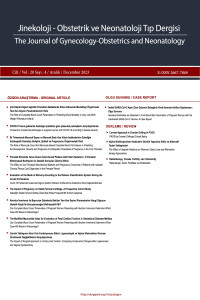Evaluation of the Mode of Delivery According to the Robson Classification System During the Covid-19 Pandemic
Öz
Aim: To show the change in the rates of vaginal delivery and cesarean section during the Covid-19 Pandemic in Ankara City Hospital. Materials and Method: This cross-sectional study included pregnant women who gave birth between 37 and 42 gestational weeks. Cesarean birth rates for each of the 10 Robson categories, compared between Covid-19 and before Covid-19 groups. Results: 21366 pregnant women were included in the study. The cesarean section rates were examined by dividing the patients who gave birth during covid -19 into two groups those who were infected with covid and those who were not. During the Covid-19 pandemic, women with previous CS (Robson group 5) and the nulliparous women who had spontaneous labor with a cephalic presentation at term (Robson group 1) were the most common contributors to the global CS rate, 21,68% and 6.5%, respectively regardless of being infected with Covid-19. Similarly, Robson group 5 makes the greatest contribution to the overall cesarean section rate (% 21,68) when we evaluate the patients by separating them as covid positive and covid negative. Conclusion: At the beginning of the epidemic higher rates of cesarean section are expected in the group of pregnant women with Covid-19 infection due to our limited knowledge. Although the mother's infection complicates the delivery, the timing and mode of delivery should be individualized according to the clinical condition of the pregnant woman, the week of gestation, and the condition of the fetus.
Anahtar Kelimeler
Cesarean section COVID-19 Delivery mode Robson classification
Destekleyen Kurum
None
Kaynakça
- 1. Betrán AP, Gulmezoglu AM, Robson M, Merialdi M, Souza JP, Wojdyla D, et al. WHO global survey on maternal and perinatal health in Latin America: classifying cesarean sec- tions. Reprod Health. 2009;6:18. 2. Golbasi C, Golbasi H, Bayraktar B, Omeroglu I, Vural T, Sahingoz Yildirim AG, et al. Cesarean delivery rates based on time and indication using the Robson Ten-Group Classifica- tion System: Assessment at a Turkish tertiary center. J Obstet Gynaecol Res. 2022. 3. Topçu HO, Özel Ş, Üstün Y. Identifying strategies to reduce cesarean section rates by using Robson ten-group clas- sification. J Matern Fetal Neonatal Med. 2021;34(16):2616-22.
Öz
Amaç: Amacımız Ankara Şehir Hastanesi'nde Covid-19 Pandemi sürecinde vajinal ve sezaryen doğum oranlarındaki değişimi göstermektir. Gereçler ve Yöntem: Bu kesitsel çalışmaya 37-42 gebelik haftaları arasında doğum yapan gebeler dahil edildi. Robson 10 kategorisinin her biri için sezaryenle doğum oranları, Covid-19 öncesi ve Covid-19 dönemleri arasında karşılaştırıldı. Bulgular: Çalışmaya 21366 gebe dahil edildi. Covid -19 sürecinde doğum yapan hastalar, Covid pozitif olanlar ve olmayanlar olarak iki gruba ayrılarak sezaryen oranları incelendi. Covid-19 pandemisi sırasında, daha önce sezaryen geçirmiş kadınlar (Robson grup 5) ve termde baş prezentasyonu ile spontan doğum yapmış nullipar kadınlar (Robson grup 1), sırasıyla %21,68 ile %6,5 ile Covid 19 olup olmadığına bakılmaksızın tüm sezaryen oranına en yaygın katkıda bulunanlardı. Aynı şekilde hastaları Covid pozitif ve Covid negatif olarak ayırarak değerlendirdiğimizde de tüm sezaryen oranına en büyük katkıyı Robson grup 5 yapmaktadır (%21,68). Sonuç: Salgının başlangıcında sınırlı bilgimiz nedeniyle Covid-19 enfeksiyonu olan gebe grubunda daha yüksek sezaryen oranları beklenmekteydi. Annede var olan enfeksiyon, doğumu zorlaştırsa da doğumun zamanlaması ve şekli gebenin klinik durumuna, gebelik haftasına ve fetüsün durumuna göre bireyselleştirilmelidir.
Anahtar Kelimeler
Kaynakça
- 1. Betrán AP, Gulmezoglu AM, Robson M, Merialdi M, Souza JP, Wojdyla D, et al. WHO global survey on maternal and perinatal health in Latin America: classifying cesarean sec- tions. Reprod Health. 2009;6:18. 2. Golbasi C, Golbasi H, Bayraktar B, Omeroglu I, Vural T, Sahingoz Yildirim AG, et al. Cesarean delivery rates based on time and indication using the Robson Ten-Group Classifica- tion System: Assessment at a Turkish tertiary center. J Obstet Gynaecol Res. 2022. 3. Topçu HO, Özel Ş, Üstün Y. Identifying strategies to reduce cesarean section rates by using Robson ten-group clas- sification. J Matern Fetal Neonatal Med. 2021;34(16):2616-22.
Ayrıntılar
| Birincil Dil | İngilizce |
|---|---|
| Konular | Kadın Hastalıkları ve Doğum |
| Bölüm | Araştırma Makaleleri |
| Yazarlar | |
| Yayımlanma Tarihi | 31 Aralık 2023 |
| Gönderilme Tarihi | 9 Mart 2023 |
| Kabul Tarihi | 24 Nisan 2023 |
| Yayımlandığı Sayı | Yıl 2023 Cilt: 20 Sayı: 4 |


